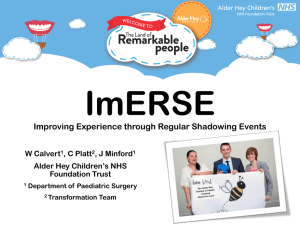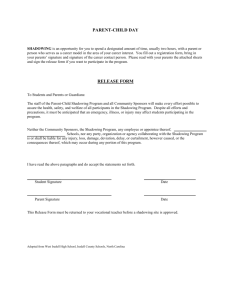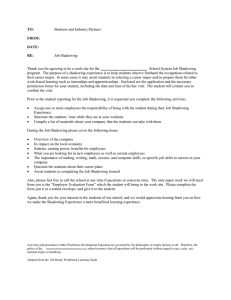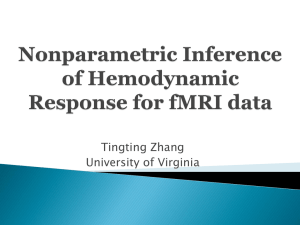Single-Session Analysis
advertisement
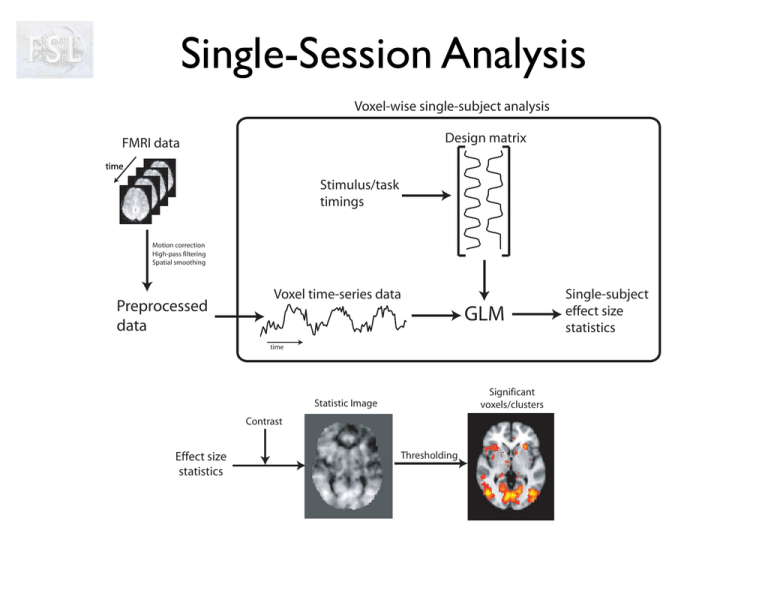
Single-Session Analysis Voxel-wise single-subject analysis Design matrix FMRI data time Stimulus/task timings Motion correction High-pass filtering Spatial smoothing Preprocessed data Voxel time-series data GLM time Significant voxels/clusters Statistic Image Contrast Effect size statistics Thresholding Single-subject effect size statistics Ti m e Two different views of the data ... A “smallish” number of volumes A large number of time series FMRI Modelling and Statistics • • • • • • An example experiment Multiple regression (GLM) T and F Contrasts Null hypothesis testing The residuals Thresholding: multiple comparison correction FMRI Modelling and Statistics • • • • • • An example experiment Multiple regression (GLM) T and F Contrasts Null hypothesis testing The residuals Thresholding: multiple comparison correction An example experiment An FMRI adaptation of a classical PET experiment • Three types of events • 1st type: Word Generation Healthy Volunteer + Screen Scanner Bed An example experiment An FMRI adaptation of a classical PET experiment • Three types of events • 1st type: Word Generation Verb is generated Catch Noun is presented Healthy Volunteer Jellyfish Screen Scanner Bed An example experiment An FMRI adaptation of a classical PET experiment • Three types of events • 1st type: Word Generation Verb is generated Fry Noun is presented Healthy Volunteer Burger Screen Scanner Bed An example experiment An FMRI adaptation of a classical PET experiment • Three types of events • 1st type: Word Generation • 2nd type: Word Shadowing Verb is repeated Swim Verb is presented Healthy Volunteer Swim Screen Scanner Bed An example experiment An FMRI adaptation of a classical PET experiment • Three types of events • 1st type: Word Generation • 2nd type: Word Shadowing Verb is repeated Giggle Verb is presented Healthy Volunteer Giggle Screen Scanner Bed An example experiment An FMRI adaptation of a classical PET experiment • • • • Three types of events 1st type: Word Generation 2nd type: Word Shadowing 3rd type: Null event Crosshair is shown Healthy Volunteer + Screen Scanner Bed An example experiment An FMRI adaptation of a classical PET experiment • • • • Three types of events 1st type: Word Generation 2nd type: Word Shadowing 3rd type: Null event Crosshair is shown z z z z z Healthy Volunteer + Screen Scanner Bed z z z zz An example experiment An FMRI adaptation of a classical PET experiment • • • • • Three types of events 1st type: Word Generation 2nd type: Word Shadowing 3rd type: Null event 6 sec ISI, random order Healthy Volunteer + Screen Scanner Bed An example experiment An FMRI adaptation of a classical PET experiment • • • • • • Three types of events 1st type: Word Generation 2nd type: Word Shadowing 3rd type: Null event 6 sec ISI, random order For 24 events of each type Giggle Swim Fry Catch Healthy Volunteer Swim + Jellyfish Burger Giggle Etc... Screen Scanner Bed FMRI Modelling and Statistics • • • • • • An example experiment Multiple regression (GLM) T and F Contrasts Null hypothesis testing The residuals Thresholding: multiple comparison correction Building a model Our task is now to build a model for that experiment What is our predicted response to the word generation events? Building a model Our task is now to build a model for that experiment What is our predicted response to the word generation events? Stick-function at each occurrence of a “generation event” ... First 100 seconds Well, hardly like this... Building a model Our task is now to build a model for that experiment What is our predicted response to the word generation events? = ⊗ First 100 seconds = HRF predicted response First 100 seconds That looks better! Building a model Our task is now to build a model for that experiment What is our predicted response to the word generation events? = ⊗ 445 seconds HRF = 445 seconds And this is the prediction for the whole time-series Building a model Our task is now to build a model for that experiment What is our predicted response to the word generation events? + prediction 445 seconds So, if we spot a time-series like this Building a model Our task is now to build a model for that experiment What is our predicted response to the word generation events? + prediction 445 seconds And then check it against our prediction we can conclude that this pixel is into word generation Building a model Our task is now to build a model for that experiment And we can do the same for the word shadowing events? ⊗ = 445 seconds = prediction 445 seconds This time we used the onset times for the shadowing events to get the predicted brain response for those Building a model Our task is now to build a model for that experiment And we can do the same for the word shadowing events? + prediction 445 seconds And we can look for voxels that match that Formalising it: Multiple regression Word Generation + Word Shadowing Unknown “parameters” ≈ β1· Observed data + β2· Predicted responses “Regressors” Slight detour: Making regressors Event timings at “high” resolution ⊗ Convolve with HRF Predictions at “high” resolution Sub-sample at TR of experiment Regressor Estimation: Finding the “best” parameter values • The estimation entails finding the parameter values such that the linear combination ”best” fits the data. + Word Generation ≈ β1· Let’s try these parameter values 0.5 Word Shadowing + β2· 0.5 Estimation: Finding the “best” parameter values • The estimation entails finding the parameter values such that the linear combination ”best” fits the data. + Word Generation ≈ β1· 0.5 Hmm, not a great fit Word Shadowing + β2· 0.5 Estimation: Finding the “best” parameter values • The estimation entails finding the parameter values such that the linear combination ”best” fits the data. + Oh dear, even worse Word Generation Word Shadowing ≈ β1· + β2· 0 1 Estimation: Finding the “best” parameter values • The estimation entails finding the parameter values such that the linear combination ”best” fits the data. + But that looks good Word Generation Word Shadowing ≈ β1· + β2· 1.04 -0.10 Estimation: Finding the “best” parameter values • The estimation entails finding the parameter values such that the linear combination ”best” fits the data. + ≈ β1· + β2· 1.10 1.02 And different voxels yield different parameters Estimation: Finding the “best” parameter values • The estimation entails finding the parameter values such that the linear combination ”best” fits the data. + ≈ β1· + β2· -0.04 -0.03 And different voxels yield different parameters One model to fit them all Ti me 1 1.10 1.02 /stats/pe1 2 /stats/pe2 1.04 .10 Model .04 .03 And we can also estimate the residual error Difference between data and best fit: “Residual error” Residual errors And we can also estimate the residual error Ti me 1 1.10 1.02 /stats/pe1 2 /stats/pe2 1.04 .10 2 Model .04 .03 /stats/ sigmasquareds Summary of what we learned so far • The “Model” consists of a set of “regressors” i.e. tentative time series that we expect to see as a response to our stimulus • The model typically consists of our stimulus functions convolved by the HRF • The estimation entails finding the parameter values such that the linear combination of regressors ”best” fits the data • Every voxel has its own unique parameter values, that is how a single model can fit so many different time series • We can also get an estimate of the error through the “residuals” General Linear Model (GLM) • This is placed into the General Linear Model (GLM) framework Regressor, Explanatory Variable (EV) Regression parameters, Effect sizes x1 x2 = 1 + 2 y = Data from a voxel X Design Matrix + e Gaussian noise (temporal autocorrelation) “Demeaning” and the GLM • The mean value is uninteresting in an FMRI session option #1 • There are two equivalent options: 1.remove the mean from the data and don’t model it 2.put a term into the model to account for the mean In FSL we use option #1 for first-level analyses and #2 for higher-level analyses A consequence is that the baseline condition in firstlevel analysis is NOT explicitly modelled (in FSL) option #2 FMRI Modelling and Statistics • • • • • • An example experiment Multiple regression (GLM) T and F Contrasts Null hypothesis testing The residuals Thresholding: multiple comparison correction t-contrasts • A contrast of parameter estimates (COPE) is a linear combination of PEs: [1 0]: COPE = 1 x 1 + 0 x 2 [1 -1]: COPE = 1 x 1 + -1x 2 = 1 = 1- • Test null hypothesis that COPE=0 t-statistic: COPE t= std(COPE) 2 t-contrasts COP E t= std(COP E) Depends on [1 0] The Model ,the Contrast and the Residual Error t-contrasts COP E t= std(COP E) } const [1 0] The Model & the Contrast and the Residual Error t-contrasts • [1 0] : EV1 only (i.e. Generation vs rest) • [0 1] : EV2 only (i.e. Shadowing vs rest) t-contrasts 1 e m Ti 1.04 .10 2 Contrast weight vector: [1 0] Model Asks the question: Where do we need this regressor to model the data, i.e. what parts of the brain are used when seeing nouns and generating related verbs? t-contrasts e m Ti 1 1.04 .10 2 Contrast weight vector: [1 0] COPE = 1 COPE = 1.04 + 0 0.10 = 1.04 = Model 1 t-contrasts e m Ti 1.04 .10 COPE t= = std(COPE) Model 1 2 = t-contrasts • [1 0] : EV1 only (i.e. Generation vs rest) • [0 1] : EV2 only (i.e. Shadowing vs rest) • [1 1] : EV1 + EV2 (Mean activation) t-contrasts T e im 1 1.10 1.02 2 Contrast weight vector: [1 1] COPE = 1 COPE = Model 1.10 + 1 1.02 = 2.12 + = 1 2 t-contrasts T e im 1.10 1.02 COPE t= = std(COPE) Model 1 2 = t-contrasts • [1 0] : EV1 only (i.e. Generation vs rest) • [0 1] : EV2 only (i.e. Shadowing vs rest) • [1 1] : EV1 + EV2 (Mean activation) • [-1 1]: EV2 - EV1 (More activated by Shadowing than Generation) • [1 -1]: EV1 - EV2 (More activated by Generation than Shadowing (t-tests are directional)) t-contrasts e m Ti 1 1.04 .10 2 Contrast weight vector: [1 COPE = 1 COPE = 1.04 1 1] 0.10 = 1.14 = Model 1 2 t-contrasts e m Ti 1.04 .10 COPE t= = std(COPE) Model 1 2 = t-contrasts T e im 1 1.10 1.02 Why [1 2 1] instead of [1 0] ? [1 [1 0] 1] = = = F-contrasts We have two conditions: Word Generation and Shadowing We want to know: Is there an activation to any condition? - FIrst we ask: Is there activation to Generation? ⇥ ⇤ 1 0 F-contrasts We have two conditions: Word Generation and Shadowing We want to know: Is there an activation to any condition? - Then we ask: Is there activation to Shadowing? ⇥ ⇤ 1 ⇥ 0 0 ⇤ 1 F-contrasts We have two conditions: Word Generation and Shadowing We want to know: Is there an activation to any condition? - Then we add the OR 1 0 0 1 F-contrasts We have two conditions: Word Generation and Shadowing We want to know: Is there an activation to any condition? Is there an activation to any condition? Is equivalent to: Does any regressor explain the variance in the data? - Then we add the OR 1 0 0 1 F-contrasts Data & Full Model F-contrasts Fit Model Full Model Estimate Residuals SSE F-contrasts [1 0] [0 1] Fit Model Estimate Residuals SSE Full Model SSR SSE F = = SSE SSR Reduced Model - F-contrasts Full Model Reduced Model SSR SSE F = = SSE = = F-contrasts - Two conditions: A,B - Is any condition significant? - Set of COPEs form an F-contrast - Or: “Is there a significant amount of power in the data explained by the combination of the COPEs in the F-contrast?” - F-contrast is F-distributed FMRI Modelling and Statistics • • • • • • An example experiment Multiple regression (GLM) T and F Contrasts Null hypothesis testing The residuals Thresholding: multiple comparison correction Null Hypothesis Testing t-statistic: β t= std(β ) Under null hypothesis, β=0, t is t-distributed (what are the chances of that?) € t Null Hypothesis Testing t-statistic: β t= std(β ) t’ Under null hypothesis, β=0, t is t-distributed P − Value = p(t > t'| β = 0) € tt € - Small P-Value = null hypothesis unlikely - If P-Value < P-threshold then voxel is “active” - P-threshold corresponds to False Positive Rate (FPR) T to P to Z t - distribution Z - distribution t’ z’ t z P • FEAT performs spatial inference on z statistic maps • Therefore, we convert t statistics to z statistics by equating probabilities under the tails of the distributions (t'-> p->z') Summary of what we learned so far • Once you have fitted your model and estimated your parameters you can ask directed questions of your data using contrasts. • A contrast can be a t-contrast, which asks relatively specific question, or an F-contrast, which can ask more general questions. • A t- or F-value specifies the “degree of surprise” of the data (given that the null-hypothesis is true). • A t- or F-value can be transformed to a z-score with the same p-value (degree of surprise). FEAT Schematic Stimulus Details HRF EV Design Matrix FEAT Schematic Preprocessed Data Stimulus Details HRF EV PEs PE covariances Design Matrix FEAT Schematic Preprocessed Data Stimulus Details HRF EV PEs PE covariances COPEs VARCOPEs Design Matrix t-stats FEAT Schematic Preprocessed Data Stimulus Details HRF EV PEs PE covariances COPEs VARCOPEs t-stats f-stats Design Matrix FEAT Schematic Preprocessed Data Stimulus Details HRF EV PEs PE covariances COPEs VARCOPEs Design Matrix t-stats z-stats f-stats zf-stats FMRI Modelling and Statistics • • • • • • An example experiment Multiple regression (GLM) T and F Contrasts Null hypothesis testing The residuals Thresholding: multiple comparison correction Choosing High-Pass Filter Cut-off • Can use the tool cutoffcalc to determine a good cut-off value Remember that MJ mentioned highpass filtering? Choosing High-Pass Filter Cut-off • Can use the tool cutoffcalc to determine a good cut-off value OR • Set by hand, but make sure model is not badly affected Example: Boxcar EV with period 100s Cut-off=100s Negligible effect on EV, so use cut-off of 100s Example: Boxcar with period 250s Cut-off=100s Cut-off=250s Substantial effect on EV, so need longer cut-off Negligible effect on EV, so use cut-off of 250s Non-independent/Autocorrelation/ Coloured FMRI noise Uncorrected, this causes: - biased stats (increased false positives) - decreased sensitivity FSL fixes it for you in FEAT! Cannot use randomise (see later) because of autocorrelation FMRI Modelling and Statistics • • • • • • An example experiment Multiple regression (GLM) T and F Contrasts Null hypothesis testing The residuals Thresholding: multiple comparison correction What happens when we apply “standard” statistical testing to imaging data? z z-map where each voxel ~N. Null-hypothesis true everywhere, i.e. NO ACTIVATIONS z-map thresholded at 1.64 16 clusters 288 voxels ~5.5% of the voxels 0.05 1.64 That’s a LOT of false positives What we really want Let’s say we perform a series of identical studies Each z-map is the end result of a study Let us further say that the null-hypothesis is true We want to threshold the data so that only once in 20 studies do we find a voxel above this threshold There will be a whole talk on how to find such a threshold Summary • The GLM is used to summarise data in a few parameters that are pertinent to the experiment. • GLM predicts how BOLD activity might change as a result of the experiment. • We can test for significant effects by using t or f contrasts on the GLM parameters • When thresholding the number of false positives needs to be controlled across the entire brain That's all folks
